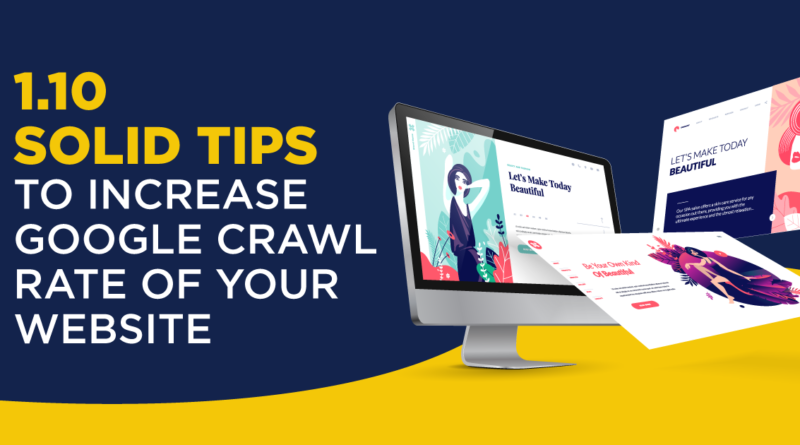10 Solid Tips To Increase Google Crawl Rate Of Your Website
Do you want to be Google’s favourite?
I bet you do! Although that may seem challenging and sometimes redundant, it’s not that difficult! Google’s algorithm is a computer that employs over 200 parameters to determine where websites rank in search results.
These are pieces of information that Google bots collect from each site during the process of a ‘Google crawl’ and take into account when filing in Google’s ‘index.’
In this blog, I’ll tell you everything you need to know about the Google crawl rate, along with 10 tips to increase the Google crawl rate of your website.
First, let’s start with the basics.
What Is Google Crawl Rate?
Google first identifies the pages that exist on the web. They check these pages to find the content that is relevant and the extent of its relevance. The process of discovering these new pages is what Google calls crawling.
Everything on your page will then be analyzed – your content, images, videos etc. Google calls this process ‘indexing’ and stores all your information to their database – Google’s index.
The frequency with which Googlebot accesses your page is referred to as the crawl rate. It will differ depending on the nature of your website and the material you provide. The average crawl duration might range from three days to four weeks, depending on various circumstances.
There are some key factors that Google looks at while crawling your website. They are your site’s:
- Popularity
- Crawlability, and
- Structure
Now, let’s answer the million-dollar question!
How to get Google to crawl your website?
There are billions of pages on the web – and Google has to go through them all. Naturally, Google can’t crawl all the websites every day, and they’ll ignore your website if:
- It has usability problems,
- the bots have trouble finding relevant information
- The quality of your content is poor
While you may never know how exactly you can win Google’s heart, you can take many steps to avoid Googlebot from ignoring your website and, as a result, boosting your crawl rate.
10 solid tips to increase Google crawl rate of your website
#1 Keep updating your content
Studies have proven that Google considers quality content as the most critical factor when it comes to crawling. To impress Google, you can constantly add new content to your website, which will give the bot something new to see every time they visit your website.
Writing blogs is the best way to keep adding new content to your website. It works much better than altering your website content or adding new web pages with irrelevant information. You can also add new images/videos to your website. Ensure to post at least three times a week to raise the Google crawl rate.
#2 Check On Your Load Time
Like I mentioned before, Google needs to crawl over hundreds of websites in a day. So, if you’re making the bot wait for a long time, it will leave your website and move on to the next one.
To improve your load time, you can get rid of large image files and PDFs. According to Google, your server time must be under 200ms. Your customers (and eventually, you) will face trouble if it’s going to be anything over that.
#3 Remove All Duplicate Content
Search engines can quickly detect duplicate content. This makes it inevitable that copied content will reduce the rate of Google crawling.
Duplicate content demonstrates a lack of focus and uniqueness. Search engines may ban your website or degrade your search engine ranks if your pages have identical material above a specific threshold.
#4 Make Use Of Sitemaps
Every piece of information on the website should be crawled, and however, this can take a long time or even never happen. One of the most crucial things you can do to make your site discoverable by Googlebot is to submit sitemaps.
A sitemap allows a website to be crawled swiftly and effectively. They will also assist you in categorizing and prioritizing your web pages. As a result, pages with meaningful content will be crawled and indexed faster than pages with less important content.
#5 Prevent Google from crawling through robots.txt
It’s pointless to allow search engine bots to browse worthless pages like admin and back-end directories because we don’t index them in Google. Thus it’s pointless to let them scan them.
Simple changes to your Robots.txt file will prevent bots from crawling this useless area of your site.
#6 Ensure Optimization For Images and Videos
Images will only appear in search results if they have been optimized. Crawlers will be unable to read ideas in the same way that humans can. Make sure to include alt tags and provide descriptions for search engines to index whenever you use photos.
The same principle applies to videos. If you’re having problems optimizing certain elements, you should use them sparingly or avoid them entirely.
#7 STAY AWAY From BlackHat SEO Practices
If you used any black hat SEO techniques, you must also remove all of the linked results. Here are some of the black hat SEO techniques that you must avoid:
- Keyword stuffing,
- the use of irrelevant keywords,
- content spam,
- link manipulation
When black hat SEO tactics are used, the result is a low-quality website for crawlers. To enhance the Google crawl rate, only utilize white hat approaches. If you want to learn how to use white hat SEO practices, you can undertake an online digital marketing course.
#8 Monitor Your Google Crawl Rate
You can now use Google Search Console to track and optimize the Google Crawl rate. Simply examine the crawl statistics there.
You can manually adjust your Google crawl rate to make it faster by following the steps outlined below. However, I would advise using it with caution only when you are experiencing troubles with bots not efficiently indexing your site.
#9 Utilize Social Media To Your Benefit
There is no indication that social sharing affects search rankings, although they speed up the indexing of fresh content.
Facebook, for example, does not allow bots to scan non-public information. In contrast, Twitter does not allow any results to be crawled at all.
Googlebot and Bingbot, on the other hand, have access to publicly available information on social media. As a result, gaining a good number of shares for your content will aid in faster crawling and indexing.
#10 Interlink Your Blog Posts
Interlinking not only allows you to send link juice to other pages on your site but also allows search engine bots to dig deeper into your site. Go back to similar old posts and add a link to your new position when you compose a new post.
This will not immediately help Google crawl rate. Still, it will assist bots in effectively crawling deep pages on your site.
Conclusion
While we may not follow step-by-step instructions on how to get a website recognized, crawled, and indexed by Google, there are enhancements that every webmaster can make to improve their chances.
Google’s primary goal is to provide searchers with the highest quality information and user experience possible; you can assist them out by optimizing your site structure and frequently producing excellent content to serve users first.
Do you have any questions? Let me know in the comments below, and I’d be happy to help!




